India
Ellora Caves
The Ellora Caves represent the epitome of Indian rock-cut architecture.
The 35 "caves" - actually structures excavated out of the vertical hill face - comprise Buddhist, Hindu and Jain temples and monasteries. The 12 Buddhist (caves 1-12), 17 Hindu (caves 13-29) and 5 Jain caves (caves 30-34), built in proximity, demonstrate the religious harmony prevalent during this period of Indian history (6th-12th century CE). The Kailasa temple (cave 16) especially stands out as it is the world’s largest monolithic temple and is decorated with fine sculptures and paintings.
Community Perspective: In the “competition” with nearby Ajanta, Ellora scores points on its architectural engineering and sculptures (Ajanta however has a more beautiful setting and more painted interiors). It’s of the “worth a journey” category and the Kailasa temple could be a WHS on its own. Be aware that the site is closed on Tuesdays.
Site Info
Official Information
- Full Name
- Ellora Caves (ID: 243)
- Country
- India
- Status
-
Inscribed 1983
Site history
History of Ellora Caves
- 1983: Inscribed
- Inscribed
- Type
- Cultural
- Criteria
- i
- iii
- vi
Links
- UNESCO
- whc.unesco.org
- Official
-
- asi.nic.in — Archaeological Survey of India
- Related
-
- sacredsites.com — Ellora also is one of the Sacred Sites
All Links
UNESCO.org
- whc.unesco.org — whc.unesco.org/
Official Website
- asi.nic.in — Archaeological Survey of India
Related Resources
- sacredsites.com — Ellora also is one of the Sacred Sites
News Article
- March 12, 2016 mashable.com — Cannabis preserved India's ancient Ellora caves from decay for 1,500 years
- Sept. 17, 2013 timesofindia.indiatimes.com — And also a new visitor centre for Ellora
Community Information
- Community Category
- Archaeological site: South (East) Asian
Travel Information
Recent Connections
-
Perfect Inscriptions
1983 -
Made out of basaltic material
"There are over 100 caves at the site, … -
On Banknotes
On the Rs 20 banknoteSee www.news9live.…
Connections of Ellora Caves
- Individual People
-
-
Travels of Hyecho
"I have arrived to the place where the Southern Indian King resides. His territory is very broad: the South extends to the Southern sea, the East to the Eastern sea, the West to the Western sea, and the north adjoins the borders of central, west and east India. The King, the chiefs, and the common people highly revere the Three Jewels. There are many monasteries and monks. Both Mahayana and Hinayana are practised. In the mountains there is a large monastery which was constructed by the Yaksas under order from the Bodhisattva Nagarjuna and not built by human beings. Moreover, the pillars were cut from rocks of the mountain and built in three stories. The monastery is over three hundred paces in circumference. During the days when Nagarjuna was alive, the monastery had over three thousand monks. But at present the monastery is ruined and there are no monks. Seven hundred years after Nagarjuna this place began to decay." - From the diary of Hyecho -
Gertrude Bell
Photo taken 15 December 1902
-
- Trivia
-
-
On Banknotes
On the Rs 20 banknote -
Cultural sites closely connected to volcanoes
Ellora occupies a relatively flat rocky region of the Western Ghats, where ancient volcanic activity had created multilayered basalt formations, known as the Deccan Traps. The volcanic activity that formed the west-facing cliff that houses the Ellora caves occurred during the Cretaceous period. (wiki)
-
- History
- Architecture
-
-
Rock Cut Architecture
"one of the largest rock-cut Hindu temple cave complexes in the world" (wiki) -
Dravidian Architecture
Kailasa: the whole temple consists of a shrine with lingam at the rear of the hall with Dravidian sikhara (AB ev) -
Made out of basaltic material
"There are over 100 caves at the site, all excavated from the basalt cliffs in the Charanandri Hills" (wiki)
-
- World Heritage Process
-
-
Perfect Inscriptions
1983
-
- Religion and Belief
-
-
Multiple Religions
Hindusim, Buddhism and Jainism. The site contains monastic caves of all 3 religions -
Buddhist sites in non-Buddhist countries
-
Jainism
Several Jain shrines (cave 30, 32, 33)
-
- Human Activity
-
-
Chariots
Ellora Cave no. 25 depicting hindu sun god with his chariot -
Erotic art
Kailasa Temple: houses mithunas (erotic male and female figures).See en.wikipedia.org
-
- Constructions
-
-
Monumental Monoliths
-
Purpose Built Visitor Centre
Buffer zone, inaugurated 2013.See wikimapia.org
-
- Timeline
-
-
Built in the 7th century
Earliest monuments date from ca. 600 (caves excavated earlier, from 5th century) (AB ev)
-
- Visiting conditions
-
-
Foreigner prices
Citizens of India and visitors of SAARC (Bangladesh, Nepal, Bhutan, Sri Lanka, Pakistan, Maldives and Afghanistan) and BIMSTEC Countries (Bangladesh, Nepal, Bhutan, Sri Lanka, Thailand and Myanmar) - Rs.30 per head. Others: Rs. 500/- per headSee asi.nic.in
-
News
- mashable.com 03/12/2016
- Cannabis preserved India's ancient…
- timesofindia.indiatimes.com 09/17/2013
- And also a new visitor centre for …
Recent Visitors
Visitors of Ellora Caves
- Alberto Rodriguez Gutierrez
- Alexander Lehmann
- A. Mehmet Haksever
- Ammon Watkins
- Artur Anuszewski
- Aspasia
- Atila Ege
- Bamse
- Bernard Joseph Esposo Guerrero
- Cheryl
- Chinmaya
- Christer Sundberg
- Clyde
- Cyberczar
- David Marton
- Dimitar Krastev
- DouglasR
- Dylan
- Els Slots
- emvcaest
- Erik Jelinek
- Fan Yibo
- fedemarch92
- Frederik Dawson
- Garrett
- gautamiyer23
- GerhardM
- Gernot
- Iain Jackson
- Ian Cade
- Ivan Rucek
- Jan-Willem
- Javier Coro
- Jezza
- Joel on the Road
- KateY
- Kevin McFarland
- Knut
- Kurt Lauer
- leroykstlj
- lichia
- Loic Pedras
- Lucio
- Ludvan
- Luis Filipe Gaspar
- Lukasz Palczewski
- Luke LOU
- Mahuhe
- Malgorzata Kopczynska
- marcel staron
- Marcobrey
- Martin
- Martina Rúčková
- Matthewsharris
- MaYumin
- mg:1
- M.HATADA
- Michael Novins
- Mikko
- Milan Jirasek
- Miloš Tašković
- Mkandasa
- MMM
- Morodhi
- Nick Kuzmyak
- Nihal Ege
- Patrik
- Paul Schofield
- Philipp Peterer
- Pink Bunny
- Pradip Tripathy
- Randi Thomsen
- Reza
- Rob Wilson
- Roman Bruehwiler
- Sandra!
- Shandos Cleaver
- Solivagant
- Stanislaw Warwas
- Svein Elias
- Szucs Tamas
- Tamara Ratz
- Tarquinio_Superbo
- Thomas Buechler
- Thomas van der Walt
- Tim Allen
- Timothy C Easton
- Vanessa Buechler
- Vincent Cheung
- Waxwing
- Westwards
- Zoë Sheng
Community Reviews
Show full reviews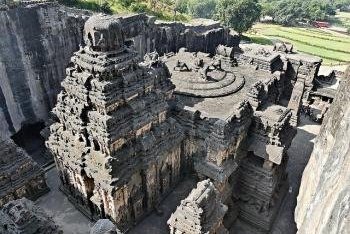
I visited this WHS in November 2016. I had already marked it as a top WHS and it surely didn't disappoint. Even though there is another great WHS relatively nearby (Ajanta Caves), I think both deserve a lengthy visit (if not a revisit) for different reasons.
Ellora Caves is made up of 34 caves from 3 different religions and the majority of the caves have beautiful carvings and/or sculptures apart from the architectural genius involved.
The closest cave to the entrance, Cave 16 or Kailasanatha temple, would easily deserve inscription alone for its unique architecture and complexity (picture). Any point of view but especially from above will help you appreciate this mindboggling piece of architecture.
My personal favourite were the Buddhist caves, especially the 2 and 3 storey ones for their rock-cut Buddhas and Cave 10 (quite similar to Ajanta's Cave 26) for its acoustic properties. The Jain caves are also worth visiting but to me were the least interesting having visited other Jain temples in India.
I spent a whole day at Ellora and I kept revisiting Cave 16 for different lighting, angles and perspectives and Cave 10 whenever a Buddhist monk visited to experience the soothing chants echoing throughout the cave. On the way to the caves from Aurangabad, I also stopped to visit the Daulatabad Fort and Minaret.
I would strongly recommend visiting Ellora and Ajanta on different days if possible so as to take them in at leisure.
Keep reading 0 comments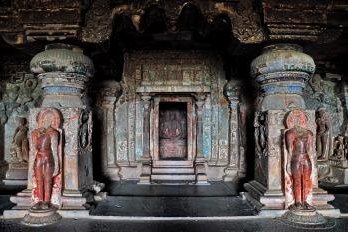
After a very satisfied tour at Ajanta Caves, I continued my journey to Ellora Caves, another rock craving wonder of India near the city of Aurangabad, to see the famous Kailasa Temple. When I arrived Ellora I was very surprised to find out that there was no tourist facilities or protection scheme like in Ajanta. From the entrance next to the main road I immediately saw the large Kailasa Temple with hundreds of tourists and a nice flower garden, a common landscape decoration in other countries’ tourist attractions, but a rare sight in India! Since the place was quite large, tourists could drive their cars to see Hindu and Jain Caves directly.
Jain caves were the first group of caves I saw, this was my first time to see Jainism temple. I was amazed with its unbelievable intricate details of rock craving and the fact that many ancient colors were still visible. The design of caves layout and details were truly unique and depiction of Jainism icons really like ancient Egyptian one. The next group I saw was the Hindu caves, I had to say that I did not feel any special with this group of caves, apart from the impressive rows of columns in cave 29 and ridiculous dry waterfall landscape. The depiction of Hinduism deity was not graceful like in Elephanta Caves near Mumbai, but the depiction of Giant also in cave 29 was truly impressive, the face really reminded me the face of Ni-o Guardian in Japan. …
Keep reading 0 comments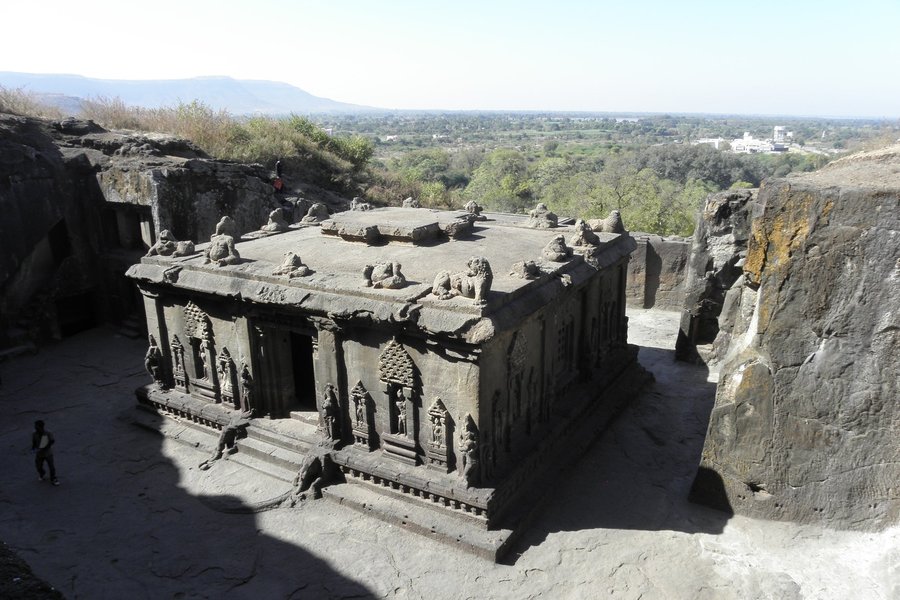
Exploring the Teen-tala cave was an uplifting experience. The way it has been designed that the worshipper becomes a part of the spiritual mandala in the third storey is indescribable. The Kailasa temple is a lesson in planning and execution. The grandeur of the temple the way it must have existed can only be imagined. I was charmed by the Gajalakshmi panel, the welcome panel, the platform of lotus leaves and the goddess above that seated in a lotus and the bathing elephants are just superb, creates a landscape of pond with blooming lotuses and cllo green leaves!
Keep reading 0 comments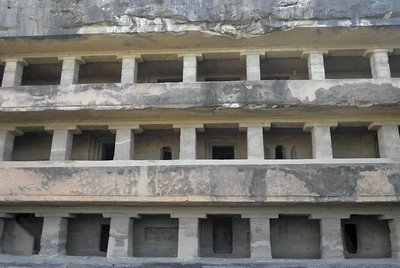
Maybe I was expecting too much: the raving reviews on this website, my memorable visits to Chinese rock-carvings in 2007, and even the rare praise from ICOMOS in the evaluation report all had me geared up to a visit of one of the highlights of the WH List. The site did fail to capture me. There were only a few caves that I found really worth seeing. They all are pretty dark inside and the floor is uneven so you have to be careful where to step. It would be good to bring a torch.
My favourite cave was number 10: a Buddhist cave, the only chaitya among the monasteries. It was used as a music gallery and has fine acoustics. The exterior has a sculptured balcony, the ceiling carved ribs. A window was placed so to illuminate the big teaching Buddha in the center of the cave.
Another one not to miss is of course the enormous Kailasha Temple. An unimaginable load of work has been done to carve this all out of a monolithic rock. Its size and structure is difficult to capture on a photo. It resembles the Churches at Lalibela (though these carvings are even cruder).
I visited on a Saturday morning, and especially the Kailasha Temple was overrun by Indian daytrippers. Young men ignore every warning sign, climb the sculptures and get overexcited on seeing a white blonde female. While travelling in India over the past weeks and attracting a lot of …
Keep reading 0 comments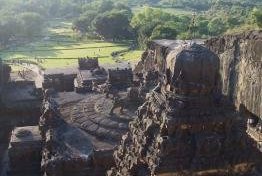
The Kailash Temple was perhaps the finest single site I saw on my whole 3 week trip in South Asia. It marks out the Ellora caves as a truly world class destination, and one that should not be missed if you are in central India.
There are three religions represented across the 32 of the complex. The Buddhist caves are the earliest, and have many similarities to those at Ajanta, but do not have the painted interiors of that site. The Jain caves have some particularly impressive carvings, they are not as large as the others but they are finely detailed.
The bulk of the highlights though come in the Hindu caves, which at times can be massive.
The Kailash temple was absolutely astounding, and could easily be a world class WHS on its own, even without the 30 other caves. The impressive style of the carvings, the monumental size and the great views afforded by the surround galleries and hill made this extra special. It was really worthwhile clambering up the hill surrounding it to get a birds-eye view of the whole ensemble.
I managed to visit the caves in the same day as Ajanta and I felt that I did each site justice, visiting every cave and having repeat viewings of the major highlights.
Astounding, don't miss if you are in central India.
[Site 10: Experience 7]
Keep reading 0 comments
I escorted a Japanese group from Kathmandu to Mumbai in 2000. We went to Elephanta Caves which was marvelous, went to Ajanta which was truly unique and then to Ellora and later to Udaypur, Jaipur and Agra and spent hours at the Taj Mahal appreciating and absorbing the beauty. I have lived in Rome for 4 years and have been several times to the Vatican, the Colosseum, fountains of Tivoli, Venicia, Pompei, etc.
Have traveled the length and breadth of India, ME, USA, Japan, SEAsia and so many places. Lived another 5 years in Japan and did the same.
Nothing, nothing in this world has fascinated me more than Ellora!! It is a place of worship, pilgrimage, meditation, study and relaxation!! It is a place to discover your inner self by comparing your own life with the lives of those who designed it, built it and were never heard of again for over a millennium ago!! It was truly mind-boggling man's gift to the world - Voila Ellora !!!!!
If you are a human being in every sense(especially from India) and have never been to Ellora - then you are missing one of mankind's greatest achievement!!!!
Keep reading 0 comments
I have been to Elura twice- and any time I am in India, I will never fail to make it a central stop of my trip. The Kailasha Temple is a wonder, carved from the living cliff. Photographs cannot capture it. Don't miss the small chapels carved into teh sidewalls of the dig-out, especially the shrine of the Saptamatrikas! The Kaila also includes one of the most beautiful scultpreus of Sri-Lakshmi I have ever seen.
The Buddhist caves are fascinating for early Buddhist iconography and understanding. Some of the acoustics are wonderful as well.
But be sure not to miss the Jain caves. Some of the finest of the sculpture and paintings are there, and there are a lot fewer people, so you can really enjoy them.
Local facilities are good- I enjoy the nearby hotel and its restaurant. Also, the local textiles are fabulous!
Keep reading 0 comments
I have visited Ellora many times when I was staying at Aurangabad. The caves are simply wounderful!Even if you visit the caves many times, you will not be satisfied. will still feel to visit the cave once more! More you visit the caves, more you fall in their love. During every visit you find a new angle, a new vision! So, make up your mind & start preparations to visit the caves at least once in a life!
Keep reading 0 comments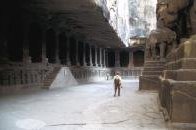
In my opinion Ellora is one of the great sites and sights of the world. It easily enters my category of “Worth a journey”. Don’t even think of not going there if you are in Central India!
The site is situated about 30kms outside the city of Aurangabad. The road to it passes the fortress of Daulatabad which is worth visiting even if you are not on the Tourist Corporation tour (We went twice to Ellora :- once on the “tour” and then the next day by ourselves to soak it up at our own pace).
At Ellora there are 3 sets of caves totalling around 30 in all – Buddhist, Hindu and Jain each with its distinctive style and iconography. But the highlight of them all is the Kailash Temple. The entire structure is cut from the living rock into a cliff face. The result is an enormous (30 metres high?) free-standing stylised representation of the holy Kailash Mountain in Tibet surrounded by caves cut deep into the side walls. As you walk round the base of the “mountain” you are in a narrow defile between it and the cliffs from which it has been hewn. Indeed you often walk under the cliffs themselves with thousands of tonnes of rock over your head (photo). All round the sides and on the face and inside the “mountain” itself are room/halls/caves and amazing sculptures of Hindu gods and symbols. And don’t forget to take in the view from above by climbing …
Keep reading 0 comments
The caves of Ellora are truly fantastic. The creator was not indulging in fantasy when looking upon his creation - the Kailasha temple - he said, 'Oh what have I created?'
The engineering and work that must have been involved in creating this wonderful place is truly mind-blowing.
Keep reading 0 comments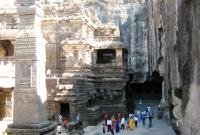
The Ellora caves reflects the three faiths of Hinduism, Buddhism and Jainism between 350 AD and to 700 AD. There are 34 temples but only 12 of them are belongs to the Buddhist period, a certain representation of the slow decline of Buddhism at the time.
The Chalukya-Rashtrakuta rulers were the main patrons of the cave temples of Ellora and many kings and merchants donated huge sums of money for the construction of the cave temples. A temple was supposed to give salvation and religious excellence to the kings.
As a first-time visitor, you are immediately impressed by the fact that all temples, pillars, balconies and sculptures have all been carved out of ONE piece of rock. It’s a dwindling thought when you realize that there is only one chance to get it all done correctly.
The masterpiece at Ellora is the Kailasa Temple. Dedicated to Shiva, it is the world’s largest monolithic sculpture, hewn from rock by over 7000 laborers over a 150-year period. Over 200.000 tons of rock has been removed to create the temple which covers an area twice the area of the Parthenon in Athens and is also 1½ times as high.
A visit to the Ellora Caves is a breathtaking experience. This is truly a World Heritage Site in the same class as the Pyramids, Petra or Taj Mahal and an absolute must place to stop at when you plan you Indian travel route.
Keep reading 0 comments
